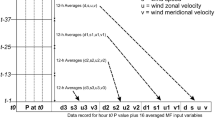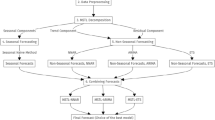Abstract
Predicting extreme winds (i.e. winds speed equal to or greater than 25 m/s), is essential to predict wind power and accomplish safe and efficient management of wind farms. Although feasible, predicting extreme wind with supervised classifiers and deep learning models is particularly difficult because of the low frequency of these events, which leads to highly unbalanced training datasets. To tackle this challenge, in this paper different traditional data augmentation techniques, such as random oversampling, SMOTE, time series data warping and multidimensional data warping, are used to generate synthetic samples of extreme wind and its predictors, such as previous samples of wind speed and meteorological variables of the surroundings. Results show that using data augmentation techniques with the right oversampling ratio leads to improvement in extreme wind prediction with most machine learning and deep learning models tested. In this paper, advanced data augmentation techniques, such as Variational Autoencoders (VAE), are also applied and evaluated when inputs are time series.
Access this chapter
Tax calculation will be finalised at checkout
Purchases are for personal use only
Similar content being viewed by others
References
Chawla, N.V., Bowyer, K.W., Hall, L.O., Kegelmeyer, W.P.: Smote: synthetic minority over-sampling technique. J. Artif. Intell. Res. 16, 321–357 (2002)
Hersbach, H., et al.: The era5 global reanalysis. Q. J. R. Meteorol. Soc. 146(730), 1999–2049 (2020)
Iglesias, G., Talavera, E., González-Prieto, A., Mozo, A., Gómez-Canaval, S.: Data augmentation techniques in time series domain: a survey and taxonomy. Neural Comput. Appl. 35(14), 10123–10145 (2023), 3
Khosla, C., Saini, B.S.: Enhancing performance of deep learning models with different data augmentation techniques: a survey. In: 2020 International Conference on Intelligent Engineering and Management (ICIEM), pp. 79–85. IEEE, London, United Kingdom (Jun 2020), 1
Kingma, D.P., Welling, M., et al.: An introduction to variational autoencoders. Found. Trends Mach. Learn. 12(4), 307–392 (2019)
Nabian, M., Eftekhari, Z., Wong, A.: CI-VAE: a class-informed deep variational autoencoder for enhanced class-specific data interpolation (2023). https://openreview.net/forum?id=jdEXFqGjdh
Sohn, K., Lee, H., Yan, X.: Learning structured output representation using deep conditional generative models (2015)
Acknowledgments
The present study has been supported by the “Agencia Estatal de Investigación (España)” (grant ref.: PID2020-115454GB-C22/AEI/10.13039/501100011033), and by the projects PID2020-115454GB-C21 and TED2021-131777B-C22 of the Spanish Ministry of Science and Innovation (MICINN). Antonio Manuel Gómez-Orellana has been supported by “Consejería de Transformación Económica, Industria, Conocimiento y Universidades de la Junta de Andalucía” (grant ref.: PREDOC-00489). David Guijo-Rubio has been supported by the “Agencia Estatal de Investigación (España)” MCIU/AEI/10.13039/501100011033 and European Union NextGenerationEU/PRTR (grant ref.: JDC2022-048378-I).
Author information
Authors and Affiliations
Corresponding authors
Editor information
Editors and Affiliations
Ethics declarations
Disclosure of Interests
The authors declare that they have no known competing financial interests or personal relationships that could have appeared to influence the work reported in this paper.
Rights and permissions
Copyright information
© 2024 The Author(s), under exclusive license to Springer Nature Switzerland AG
About this paper
Cite this paper
Vega-Bayo, M. et al. (2024). Data Augmentation Techniques for Extreme Wind Prediction Improvement. In: Ferrández Vicente, J.M., Val Calvo, M., Adeli, H. (eds) Bioinspired Systems for Translational Applications: From Robotics to Social Engineering. IWINAC 2024. Lecture Notes in Computer Science, vol 14675. Springer, Cham. https://doi.org/10.1007/978-3-031-61137-7_28
Download citation
DOI: https://doi.org/10.1007/978-3-031-61137-7_28
Published:
Publisher Name: Springer, Cham
Print ISBN: 978-3-031-61136-0
Online ISBN: 978-3-031-61137-7
eBook Packages: Computer ScienceComputer Science (R0)




